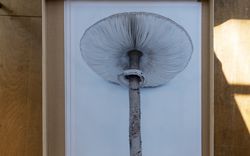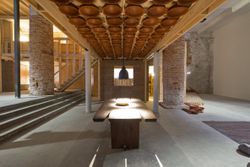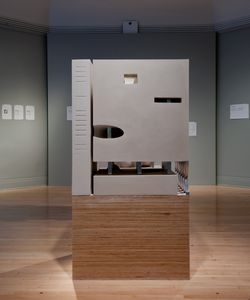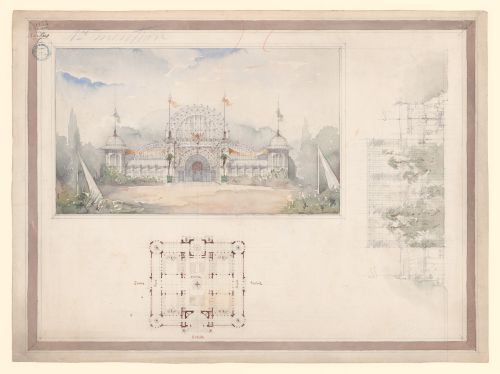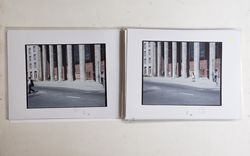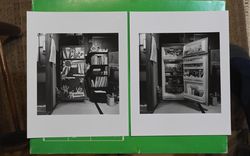archives
Niveau de description archivistique:
Fonds
Fonds Peter Rose
AP046
Résumé:
The Peter Rose fonds, documents the design and construction of the Canadian Centre for Architecture (1989) and a design for the redevelopment of the Old Port of Montréal, Master Plan (1992) by architect Peter Rose. Both projects include drawings, textual records, models and photographs.
1983-1989
Fonds Peter Rose
Actions:
AP046
Résumé:
The Peter Rose fonds, documents the design and construction of the Canadian Centre for Architecture (1989) and a design for the redevelopment of the Old Port of Montréal, Master Plan (1992) by architect Peter Rose. Both projects include drawings, textual records, models and photographs.
archives
Niveau de description archivistique:
Fonds
1983-1989
articles
Nouveau documentaire
La vie des documents, la photographie en tant que projet, Stefano Graziani et Bas Princen, Takashi Homma, conversation, histoire orale, vagues, champignons
15 mai 2023
Nouveau documentaire
Takashi Homma en conversation avec Stefano Graziani et Bas Princen
Actions:
La connaissance du bâti
Au cours de cette conférence, Madame Kundoo parlera d’un éventail de projets tirés de sa pratique, de sa recherche et de son enseignement. Dans ces sphères de travail distinctes mais complémentaires, elle tente de bâtir un savoir collectif, en collaboration avec des ingénieurs, des maçons, des dessinateurs, des producteurs d’infrastructure, des résidents, des fournisseurs(...)
Théâtre Paul-Desmarais
16 avril 2015 , 18h
La connaissance du bâti
Actions:
Description:
Au cours de cette conférence, Madame Kundoo parlera d’un éventail de projets tirés de sa pratique, de sa recherche et de son enseignement. Dans ces sphères de travail distinctes mais complémentaires, elle tente de bâtir un savoir collectif, en collaboration avec des ingénieurs, des maçons, des dessinateurs, des producteurs d’infrastructure, des résidents, des fournisseurs(...)
Théâtre Paul-Desmarais
Située à Paris, la Bibliothèque nationale de France, super-bibliothèque combinant cinq collections nationales sous un même toit, a été l’étape finale des grands travaux lancés par le président François Mitterrand. Organisé à l’origine pour offrir un lieu à toute la production de mots, d’images et de sons depuis 1945, le concours d’architecture a révélé la diversité et(...)
Salle octogonale
15 mai 2012 au 9 septembre 2012
Très Grande Bibliothèque (Very Big Library)
Actions:
Description:
Située à Paris, la Bibliothèque nationale de France, super-bibliothèque combinant cinq collections nationales sous un même toit, a été l’étape finale des grands travaux lancés par le président François Mitterrand. Organisé à l’origine pour offrir un lieu à toute la production de mots, d’images et de sons depuis 1945, le concours d’architecture a révélé la diversité et(...)
Salle octogonale
dessins
Quantité:
18 File
ARCH33470
Description:
squash court, operating room, janitor's kitchen, encephalography room, dark room, stair, shelves, library, lecture room, reception room, photographer's room, main vestibule, reflector plate, rubber tile floor, steps, bracket, gallery screen
Squash court, operating room, janitor's kitchen, encephalography room
Actions:
ARCH33470
Description:
squash court, operating room, janitor's kitchen, encephalography room, dark room, stair, shelves, library, lecture room, reception room, photographer's room, main vestibule, reflector plate, rubber tile floor, steps, bracket, gallery screen
dessins
Quantité:
18 File
Projet
AP056.S1.1991.PR02
Description:
This project series documents the design of Cité Collégiale in Ottawa, Ontario from in 1991. The project number assigned by the office is unidentifiable. This project consisted of a competition entry for the first French language community college to be built in Ontario. The design proposed focused on the balance between the natural landscape of the site, located on Montreal Road at Aviation Parkway, the rigor of the study program and the relaxation of student life. Large wooded areas surrounding the campus would be preserved and four functional outdoor spaces would be created: La Place des Festivals (an esplanade), the theatre (for outdoor festivities), Le Carrefour des Étudiants (the student square), and le Foyer (next to the cafeteria). The campus also proposed la Grande Galerie, a triple-height space filled with natural light to serve as the main area where students could meet and study. Two types of school buildings were included in the proposal, consisting of a long, rectangular building for classrooms and offices, and the other, a less formal, open space with classrooms, amphitheatres, studios and laboratories. The scheme had two main entrances, with a large central tower that was visible when arriving from either direction. This was not the winning entry for the competition and the campus was eventually built by Brook, Brisbin and Baynon. The project is recorded through drawings, presentation paintings and a model dating from 1991. The drawings include site condition maps, sketches, perspectives, plans, elevations, axonometric drawings and presentation panels.
1991
Cité Collégiale Competition, Ottawa, Ontario (1991)
Actions:
AP056.S1.1991.PR02
Description:
This project series documents the design of Cité Collégiale in Ottawa, Ontario from in 1991. The project number assigned by the office is unidentifiable. This project consisted of a competition entry for the first French language community college to be built in Ontario. The design proposed focused on the balance between the natural landscape of the site, located on Montreal Road at Aviation Parkway, the rigor of the study program and the relaxation of student life. Large wooded areas surrounding the campus would be preserved and four functional outdoor spaces would be created: La Place des Festivals (an esplanade), the theatre (for outdoor festivities), Le Carrefour des Étudiants (the student square), and le Foyer (next to the cafeteria). The campus also proposed la Grande Galerie, a triple-height space filled with natural light to serve as the main area where students could meet and study. Two types of school buildings were included in the proposal, consisting of a long, rectangular building for classrooms and offices, and the other, a less formal, open space with classrooms, amphitheatres, studios and laboratories. The scheme had two main entrances, with a large central tower that was visible when arriving from either direction. This was not the winning entry for the competition and the campus was eventually built by Brook, Brisbin and Baynon. The project is recorded through drawings, presentation paintings and a model dating from 1991. The drawings include site condition maps, sketches, perspectives, plans, elevations, axonometric drawings and presentation panels.
Project
1991
Projet
University Art Museum
AP143.S4.D65
Description:
File documents the unexecuted project for the University Art Museum, Long Beach, California. Material in this file was produced between 1986 and 1988. California State University, Long Beach (CSULB), commissioned Eisenman/Robertson Architects to design an art museum adjacent to the main campus entrance. The 67,500-square-foot building was to comprise four galleries, a black-box theater, an auditorium, a cafe, conference rooms, a library, offices, preparation spaces, and storage vaults. The project, sited on a 23-acre arboretum, included landscaping; terraced sculpture courtyards, botanical gardens, and a two-acre pond. Eisenman linked the northern and southern parts of the arboretum by an elevated public walkway through the museum. Sets of drawings were presented on 8 and 30 April, 2 June, and 5 Aug. In the first design phase Eisenman explores the cartographic figures which form the basis of his artificial excavation when superposed: a series of sketches establishes the analogical relationships which fix the relative scales of the plans and produce the superpositions; another series contextualizes the superposed figures by placing them within the museum site (DR1987:0859:087-090). The second phase concerns the building; the working model shows the building carved out of a square pit, from which spring an oil derrick and a reconstruction of a recreational pier (Rainbow Pier, 1920s) used here as circulatory bridge (DR1987:0859:160). In the third phase the architect systematizes his archeological procedure by using five significant cartographic dates - 1849, 1889, 1949, 1989, 2049 - each corresponding to a specific superposition (see DR1987:0859:274-277). In the fourth phase, Eisenman simplifies the superposition of 2049 to a few iconic colour-coded forms: ranch (green), ranch house (blue), campus site (red), and water forms (river and pond) (gold). Material for the fourth phase includes three relief models, four presentation drawings, and a model (property of the CSULB) (relief models: DR1987:0859:001-003; drawings: DR1987:0859:004-008). Eisenman "inhabits" his artifical archeology by detailed planning of interior spaces, and gives substance to the cartographic traces in a series of sketch sections, perspectives, and working models. Working models reveal how the central "canal" area gradually became the museum's access point (DR1987:0859:484-490); the museum, galleries, offices, and preparation areas are on one side of this deep cut, while the cafeteria and black-box theater are on the other. The upper level was to house offices, meeting rooms, and the library. File contains audiovisual material, conceptual drawings, design development drawings, presentation drawings, reference drawings, working drawings, photographic materials, and textual records.
1986-1988
University Art Museum
Actions:
AP143.S4.D65
Description:
File documents the unexecuted project for the University Art Museum, Long Beach, California. Material in this file was produced between 1986 and 1988. California State University, Long Beach (CSULB), commissioned Eisenman/Robertson Architects to design an art museum adjacent to the main campus entrance. The 67,500-square-foot building was to comprise four galleries, a black-box theater, an auditorium, a cafe, conference rooms, a library, offices, preparation spaces, and storage vaults. The project, sited on a 23-acre arboretum, included landscaping; terraced sculpture courtyards, botanical gardens, and a two-acre pond. Eisenman linked the northern and southern parts of the arboretum by an elevated public walkway through the museum. Sets of drawings were presented on 8 and 30 April, 2 June, and 5 Aug. In the first design phase Eisenman explores the cartographic figures which form the basis of his artificial excavation when superposed: a series of sketches establishes the analogical relationships which fix the relative scales of the plans and produce the superpositions; another series contextualizes the superposed figures by placing them within the museum site (DR1987:0859:087-090). The second phase concerns the building; the working model shows the building carved out of a square pit, from which spring an oil derrick and a reconstruction of a recreational pier (Rainbow Pier, 1920s) used here as circulatory bridge (DR1987:0859:160). In the third phase the architect systematizes his archeological procedure by using five significant cartographic dates - 1849, 1889, 1949, 1989, 2049 - each corresponding to a specific superposition (see DR1987:0859:274-277). In the fourth phase, Eisenman simplifies the superposition of 2049 to a few iconic colour-coded forms: ranch (green), ranch house (blue), campus site (red), and water forms (river and pond) (gold). Material for the fourth phase includes three relief models, four presentation drawings, and a model (property of the CSULB) (relief models: DR1987:0859:001-003; drawings: DR1987:0859:004-008). Eisenman "inhabits" his artifical archeology by detailed planning of interior spaces, and gives substance to the cartographic traces in a series of sketch sections, perspectives, and working models. Working models reveal how the central "canal" area gradually became the museum's access point (DR1987:0859:484-490); the museum, galleries, offices, and preparation areas are on one side of this deep cut, while the cafeteria and black-box theater are on the other. The upper level was to house offices, meeting rooms, and the library. File contains audiovisual material, conceptual drawings, design development drawings, presentation drawings, reference drawings, working drawings, photographic materials, and textual records.
File 65
1986-1988
DR1978:0014:010
Description:
- A student project for a glass exhibition building entitled "Exp[osition] d'Horticulture" and described in elevation, plan, and section. The plan shows a square structure with circular pavilions in the corners and entrances in the middle of each side. The elevation (showing the principal façade) indicates that the main hall is a tripartite structure with a tall, barrel-vaulted mid-section flanked by two lower, semi-barrel-vaulted sections. This main hall is encased by a one-storey gallery connecting the four pavilions in the corners.
architecture
1887
Student project for an exhibition greenhouse
Actions:
DR1978:0014:010
Description:
- A student project for a glass exhibition building entitled "Exp[osition] d'Horticulture" and described in elevation, plan, and section. The plan shows a square structure with circular pavilions in the corners and entrances in the middle of each side. The elevation (showing the principal façade) indicates that the main hall is a tripartite structure with a tall, barrel-vaulted mid-section flanked by two lower, semi-barrel-vaulted sections. This main hall is encased by a one-storey gallery connecting the four pavilions in the corners.
architecture
articles
Pèlerinage photographique
La vie des documents, la photographie en tant que projet, Stefano Graziani et Bas Princen, Guido Guidi, conversation, histoire orale
27 juin 2023
Pèlerinage photographique
Guido Guidi en conversation avec Stefano Graziani et Bas Princen
Actions:
articles
Observations familières
La vie des documents, la photographie en tant que projet, Stefano Graziani, Bas Princen, Tokuko Ushioda, Ice Box, My Husband
17 juillet 2023
Observations familières
Tokuko Ushioda en conversation avec Stefano Graziani et Bas Princen
Actions:
